You're viewing old version number 17. - Current version
Making pizza from spent grains
Jul 5, 2014
Using spent grains from our Dark-eyed Junco Imperial Stout that was brewed on Mar 30, 2014.
On brew day, I placed some of the spent grains in two, thick, air-tight, plastic containers, and I placed the containers in the freezer on brew day.
A few weeks later, I pulled one of the containers from the freezer and dried the grains over about two or three day period. The soaked grains take a while to dry. I tried placing the grains in the oven for a while, but that made them wet and hot.
After the grains finally dried, I placed them into an air-tight container and placed the container in the refrigerator.
On July 5, I finally decided to try using the grains in a pizza recipe.
First, I pulverized some grains in our Vitamix. I pulverized the grains into a powder, but I used the Vitamix for under 30 seconds. Next time, grind for nearly a minute, since I found some twiggy-like aspects in the grains. So the spent grains are as powder as I would prefer.
The recipe:
- 110 g of spent grains, pulverized into mostly powder.
- 550 g of all-purpose flower
- 455 g of water (frig temp)
- 13 g of fine-grain sea salt
- 4 g dry active instant yeast
After grinding the spent grains, the powdery mixture was colored a dark brown.
After mixing all the dry ingredients, the mixture had the color of buckwheat flour. It was colored a medium grey.
After adding water, the mixture became a dark grey color.
I could have used more water, prob 500 g. The initial mixture produced a stiff dough. This may not ferment nor proof very puffy, and it may be difficult to stretch.
No gluten, of course, in these spent grains.
Maybe next time, try only 55 g of spent grains. Start small and work up.
Oh well. We'll see.
- autolysed for 25 minutes. afterward, the dough felt great. no need to add more water to the recipe.
- kneaded dough for a little over 4 minutes. the dough got stickier near the end.
set dough up at 2:45 p.m. air temp / house temp in the mid to upper 70s. will prob ferment for 2 to 3 hours. i used a slightly lower amount of yeast.
- dough fermented 3 hours and it did well, about an inch or so from the bowl edge.
- divided and shaped dough into 4 rounds. Placed dough up to proof at 6:00 pm.
Dough proofed well. It moved more vertically than my typical pizza dough recipes, which spread out vertically and horizontally. This spent-grains-enhanced dough had good shape. Bizarre color though. Fun.
The first dough blob that was made into a pizza proofed for 2 hours.
The dough was soft and airy after proofing, but it was stiff to form into a crust. I had to patient. The stretching and shaping went slow.
The crust baked chewy, and it was probably the ugliest-looking crust, but it tasted great. The spent grains added a mild flavor. The spent grains contributed mostly to a chewier crust. And the color change, which wound up a dark grey, nearly charcoal-colored crust.
It was Neapolitan-style, I guess. I used Scarpetti marinara sauce, Turkey Foot Creek chevre goat cheese, olive oil, coarse Hawaiian red sea salt, and after baking, basil from the potted plant in our backyard.
Bizarre-colored, amazingly dark crust, but it tasted great. It turned out better than expected.
We were out of my wife's canned pasta/pizza sauce, made last fall, so we used a commercial option called Scarpetti.
Basil from our backyard topped the pizza after baking.
Salad contained greens from our garden, topped with Nasturtium from our backyard.
We didn't have any of our stout chilling, so we drank a couple Trappist beers.
Prior to baking, the oven was warmed for at least 40 minutes at 500 degrees with the pizza stone placed at the third level from the top, so approximately in the middle of the oven. I assumed it would be a chewy crust, so I baked it higher from the bottom, so that the crust would not bake too much and get too hard. That's my theory, anyway.
Photos
During pizza assembly, I drank a Trappist beer.

Dried spent grains as they exist on the left and after some were pulverized in the Vitamix on the right.
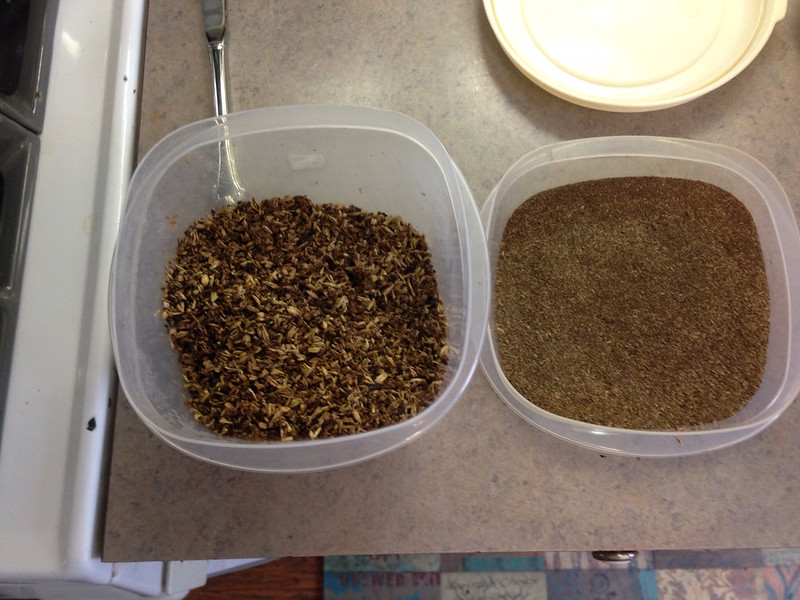
After dried ingredients were mixed, the overall color of the flour looked like buckwheat flour. Then I began adding water.
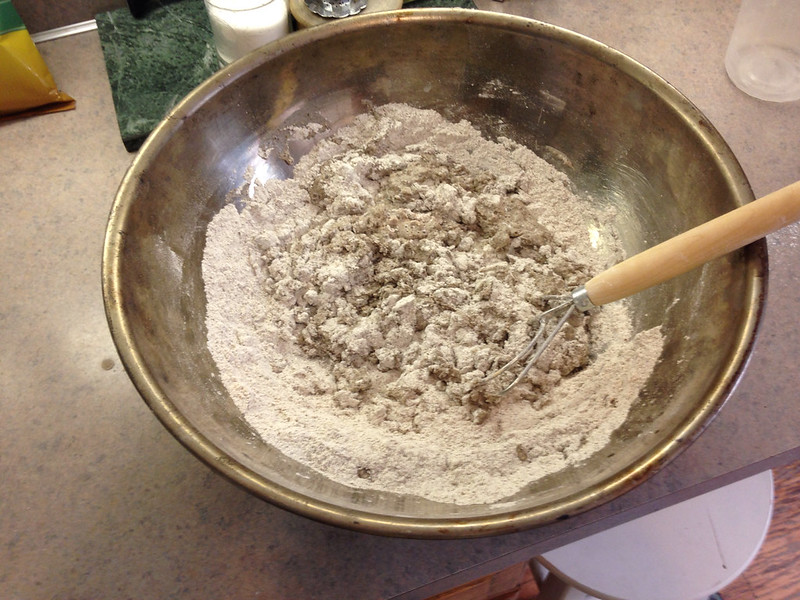
When the ingredients were mixed in the bowl by the whisk and by hand to form a sticky ball, I placed the dough on the counter, covered with the bowl, and let the dough autolyse for 25 minutes. Then I kneaded the dough on the counter for a little over four minutes. This is the dough after kneading.

The kneaded dough was placed into a lightly oiled (olive oil) bowl and covered with plastic.
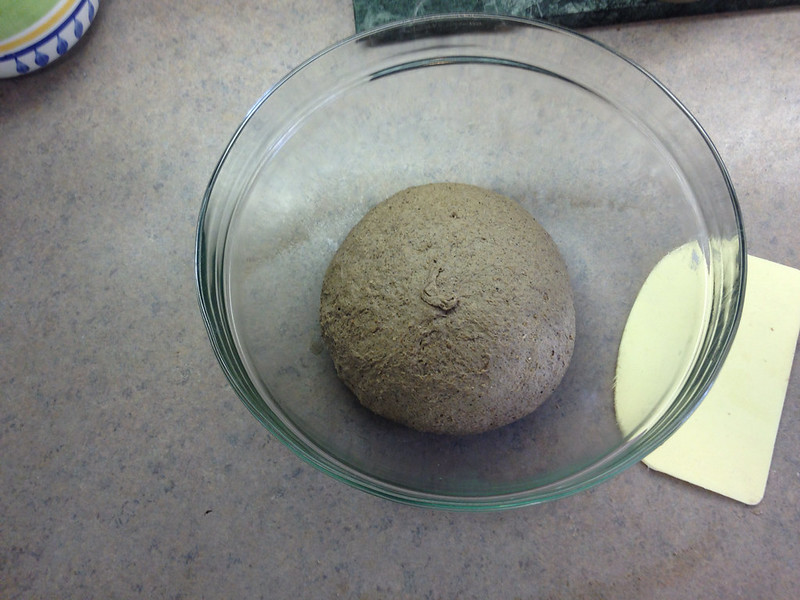
After three hours of fermentation, the dough puffed up a fair amount, although not as much as with my other pizza recipes. The spent grains would have little to no gluten properties, and since it made a stiff dough, it's possible that the spent grains inhibited dough grown or structure. But this dough fermented larger than I expected.
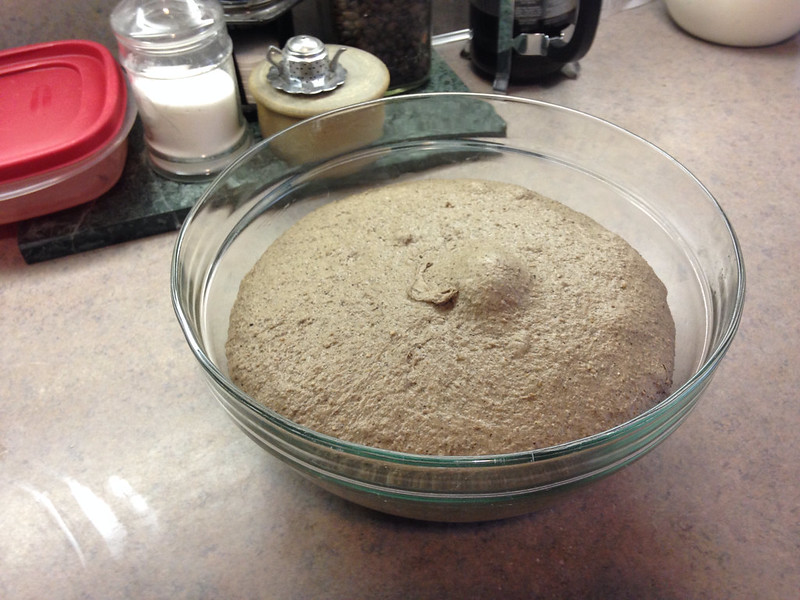
Before going into the oven.

After baking and being topped with fresh, backyard basil.
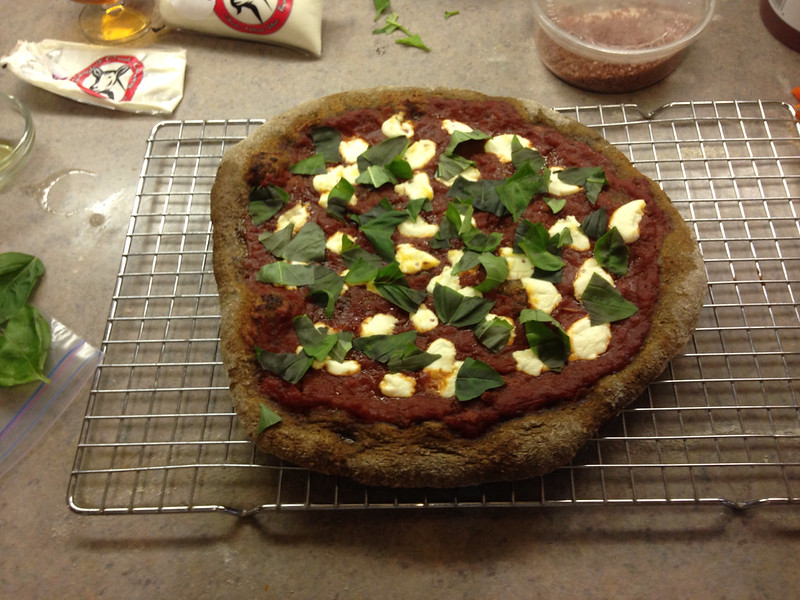
I baked two pizzas, and ate the leftovers the next day. It's a thicker crust than I normally make, but the stiff dough made it that way. Chewy with a mild flavor. We liked it a lot.

Some of the tools and ingredients used. No white whole wheat flour was used in the recipe. I scattered some of this flour onto the wood peel, so that the dough could slide easily onto the stone.
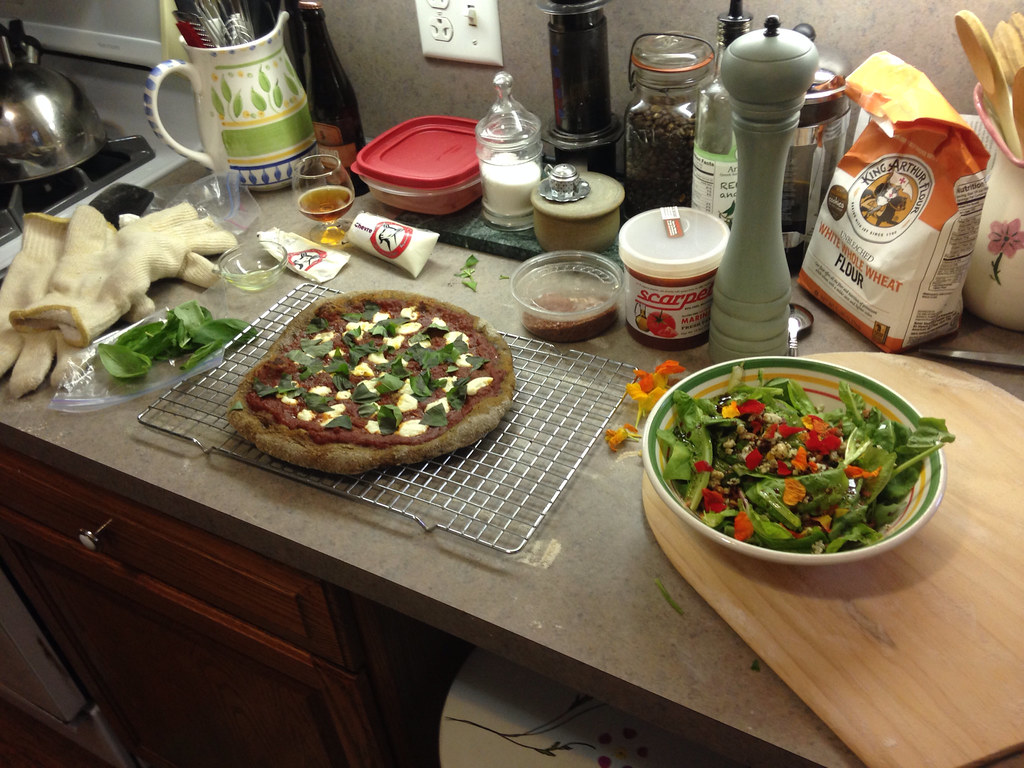
I liked the red Chimay Trappist beer a lot. Reddish-orange color.

From JR's : articles
993 words - 5531 chars
- 5 min read
created on
updated on
- #
source
- versions
Related articles
Making pizza from spent beer grains - Jul 07, 2014
Belgian beer talk and homebrewing - May 19, 2016
Homemade Neapolitan-style pizza - Apr 15, 2014
Making Pizza - Apr 25, 2014
Tt proposed pizza comment - mon, oct 26, 2015 - Oct 26, 2015
more >>